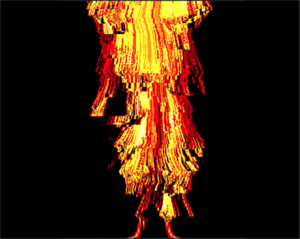Combustion Research
Wildland Fires

Faculty: Thomas Fletcher, David Lignell
Improved models of wildland fires are desired to know where and when to fight fires, what strutures can be saved, and when to have prescribed burns. We are performing fundamental research on live shrubs (Dr. Fletcher) and on turbulence-chemistry interactions in buoyant flames (Dr. Lignell).
More information:
Coal Gasification

Faculty: Thomas Fletcher
Coal gasification is being explored worldwide as a method to produce liquid fuels, chemicals, and electricity. The advantage of gasification is that it provides a pure CO2 stream for sequestration. Our projects are to provide the fundamental kinetic parameters of coal gasification at high temperatures and pressures, along with physical properties of the corresponding chars. The BYU Pressurized Flat-Flame Burner can reach conditions of 15 atm and 2000 K.
More information:
Direct Numerical Simulation

Faculty: David Lignell
Direct numerical simulation (DNS) is a powerful computational technique providing high-fidelity data of turbulence-chemistry interactions. Turbulence is characterized by a wide range of time and length scales requiring high grid resolution resulting in high computational cost. Turbulent flow simulations require subgrid models to account for unresolved turbulent structures and their effect on transport. DNS is being used to provide fundamental insights into key processes such as flame extinction and reignition phenomena, and soot formation and transport (shown at left). DNS also provides fully-resolved flow and chemical state fields, that are used to develop and validate advanced combustion models.
More information:
One Dimensional Turbulence

Faculty: David Lignell
Full resolution of three-dimensional turbulence fields is very costly from a computational viewpoint. The ODT model fully resolves a flow field along a notional line-of-sight. Turbulent advection is simulated through stochastic eddy events that are implemented through grid rearrangements via triplet maps. These eddy events occur with a given size, location, and frequency that depends on the evolution of the velocity field itself, in a way that mimimics that turbulent energy cascade. The figure above shows the temperature field for a buoyant ethylene fire.
More information: